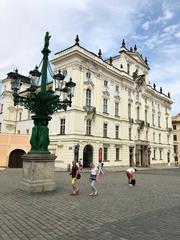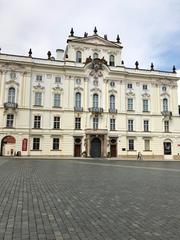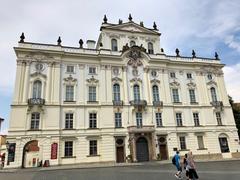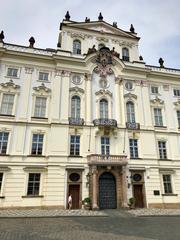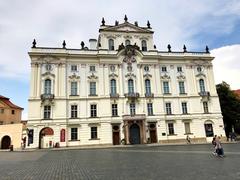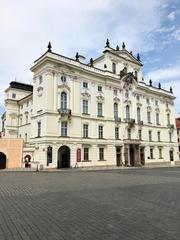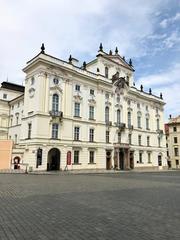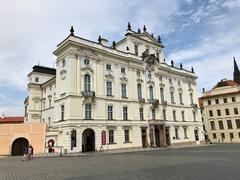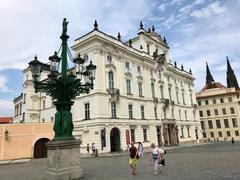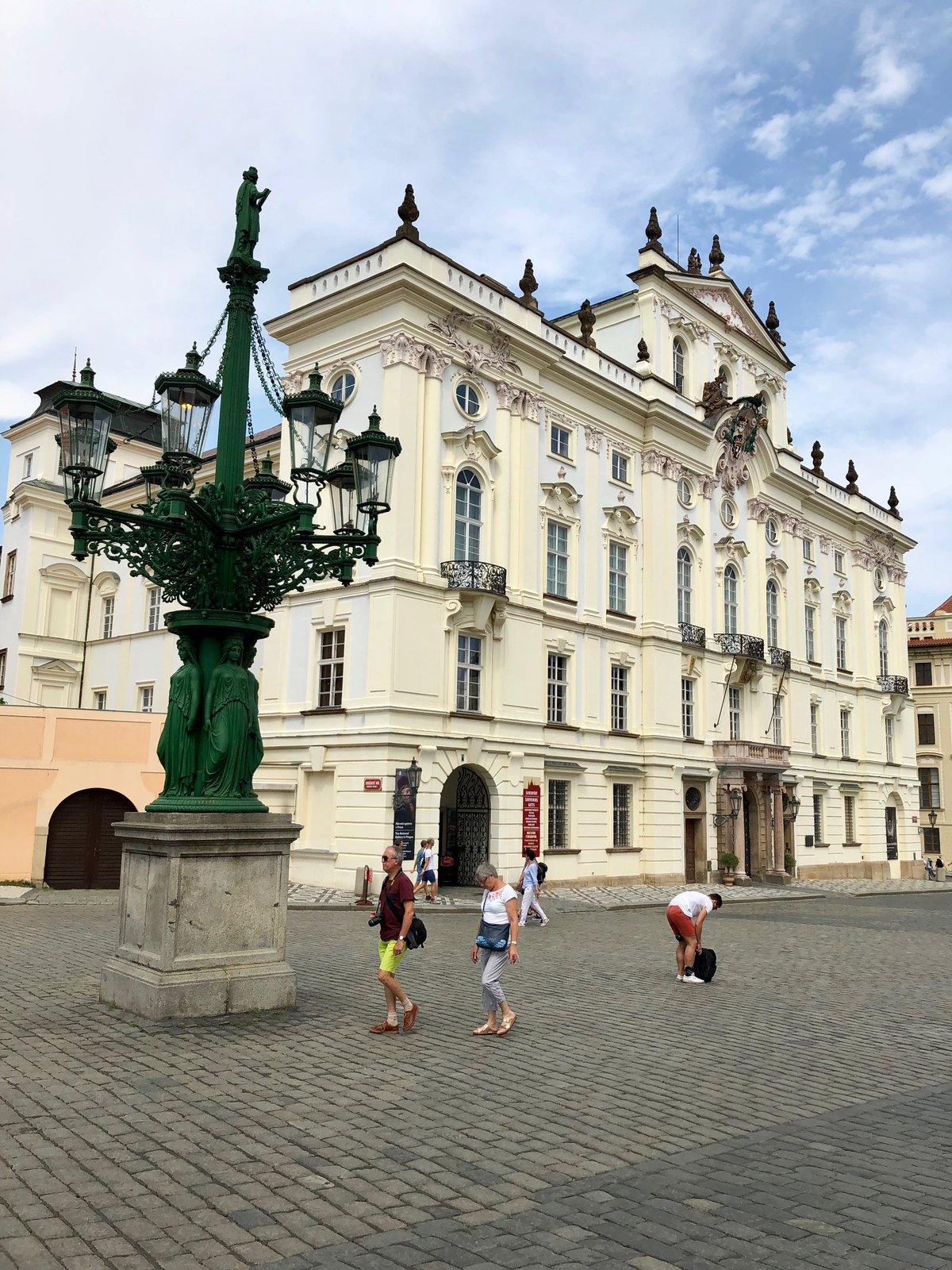
Archbishop’s Palace Prague: Visiting Hours, Tickets, and Travel Guide
Date: 14/06/2025
Introduction
The Archbishop’s Palace (Arcibiskupský palác) in Prague is a striking symbol of the city’s religious, cultural, and architectural heritage. Serving as the official residence and administrative center of the Archbishops of Prague since 1562, the palace stands on Hradčanské náměstí, opposite Prague Castle, and showcases an elegant blend of Renaissance, Baroque, and Rococo styles. While generally closed to the public, the palace periodically opens for special events, offering rare glimpses into its lavish interiors and art collections. This guide presents an in-depth look at the palace’s history, architecture, cultural significance, and provides practical information on visiting hours, tickets, accessibility, and travel tips to help you plan an enriching visit (prague.cz).
Table of Contents
- Introduction
- Historical Overview
- Architectural Features and Artistic Highlights
- Visiting Information
- Cultural and Religious Significance
- Historical Events and Legacy
- Practical FAQ
- Summary and Recommendations
- References
Historical Overview
Origins and Early History
Built on the site of medieval townhouses, the Archbishop’s Palace’s roots trace back to the mid-16th century. Initially constructed as a private mansion for Florian Griespek of Griesbach, the property was purchased by Emperor Ferdinand I in 1561 and soon gifted to Antonín Brus of Mohelnice, the first post-Hussite Archbishop of Prague. Since then, the palace has continuously served as the seat of the archbishops, making it a cornerstone of Prague’s ecclesiastical history (prague.cz; prague-guide.co.uk).
Architectural Transformation: Renaissance to Rococo
The palace underwent a Renaissance transformation in the early 1560s led by architect Bonifac Wohlmut, with Italian influences introduced by Ulrico Aostalli. The 17th and 18th centuries brought Baroque and later Rococo reconstructions under architects Jean Baptiste Mathey, Francesco Lurago, and Johann Joseph Wirch. The result is a palace that seamlessly fuses Renaissance sgraffito, Baroque monumentality, and Rococo ornamentation, culminating in the distinctive pastel-hued façade completed in 1764 (prague-navigator.com).
Architectural Features and Artistic Highlights
Exterior and Façade
The palace’s Rococo façade is a masterpiece of 18th-century design, featuring stucco reliefs, decorative cartouches, and the archbishop’s coat of arms. Its grand stairway and ornate balcony overlook Hradčanské náměstí, while sculptural balustrades and a rhythmic arrangement of windows and pilasters project stately elegance. The façade stands in harmony with nearby palaces and the monumental Prague Castle, contributing to the square’s architectural diversity (prague-guide.co.uk).
Interiors: Ceremonial Halls, Chapel, and Collections
Inside, the palace boasts ceremonial halls adorned with gilded mirrors, period furnishings, crystal chandeliers, and a remarkable collection of nine Parisian Gobelin tapestries with exotic “New India” motifs. The Chapel of St. John the Baptist remains a highlight, featuring pristine Renaissance stuccoes and original wall paintings. The palace also houses rare artifacts such as the archbishop’s ceremonial carriage—one of only two surviving in Europe—underscoring the grandeur and tradition of ecclesiastical Prague (prague-navigator.com).
Visiting Information
Visiting Hours
The Archbishop’s Palace is not open for daily public visits. Access is restricted to special occasions—such as the day before Good Friday, Open Garden Weekend (usually in June), or the Night of Churches (typically May)—with visiting hours typically from 10:00 AM to 4:00 PM. Always check the official Archdiocese website or local tourism portals for current schedules.
Tickets and Booking
Entry may be free or ticketed depending on the event. Tickets are available online via official tourism sites or at Prague Castle ticket offices. Advance booking is highly recommended, especially during peak seasons or major events.
Accessibility
Due to its historical status, some areas of the palace are not fully accessible to visitors with mobility impairments. The square and façade can be enjoyed by all, but those requiring access accommodations should contact organizers in advance for up-to-date information.
Guided Tours
Guided tours are occasionally offered during special openings, providing expert commentary on the palace’s history, architecture, and art. These tours may grant access to ceremonial halls, the chapel, and other restricted areas. Booking in advance is advised.
Visitor Tips
- Combine Visits: Plan to visit nearby sites such as Prague Castle, St. Vitus Cathedral, and the Loreta complex.
- Best Time: Spring and autumn weekdays are less crowded. Early mornings or late afternoons offer the best lighting for photography.
- Getting There: Accessible by tram (lines 22 and 23, stop: Pražský hrad), or by foot from Malostranská metro station.
- Amenities: Cafés and shops are available nearby, but tend to be pricier than those in other neighborhoods (destinationabroad.co.uk).
Cultural and Religious Significance
As the seat of the Archbishop of Prague and the central hub of the Roman Catholic Archdiocese, the palace has played a pivotal role in Czech religious and political life. It has hosted royal coronations, ecclesiastical synods, and state receptions, reflecting centuries of church-state interplay. The chapel, art collections, and ceremonial spaces all underscore the palace’s function as a locus of spirituality, diplomacy, and cultural patronage (prague.net; frh-europe.org).
Historical Events and Legacy
Throughout its history, the palace has witnessed significant events, from papal visits—such as Pope John Paul II in 1990—to royal ceremonies and religious processions. Its evolution from Renaissance beginnings through Baroque and Rococo expansions mirrors Prague’s broader artistic and spiritual transformation. Today, the palace remains both a working residence and a preserved monument within the UNESCO-listed historic center (prague-guide.co.uk).
Practical FAQ
Q: Is the Archbishop’s Palace open to visitors year-round?
A: No, the palace is usually closed to the public but opens for special events and guided tours announced in advance.
Q: How do I get tickets for a visit?
A: Tickets, when required, can be purchased online or at designated ticket offices during special openings. Check official websites for details.
Q: Are guided tours available?
A: Yes, but only during special openings or by arrangement. Tours provide access to key interiors and expert historical interpretation.
Q: Is the palace accessible for visitors with disabilities?
A: Accessibility is limited due to the building’s historic nature. Contact organizers before your visit for current accommodations.
Q: What else can I see nearby?
A: Explore Prague Castle, St. Vitus Cathedral, the Loreta complex, and the Marian Plague Column, all within walking distance.
Summary and Recommendations
The Archbishop’s Palace is one of Prague’s most significant historical and religious landmarks. While regular access is restricted, special events and guided tours provide exceptional opportunities to experience its architectural splendor, rich collections, and spiritual atmosphere. Even from the outside, the palace’s Rococo façade and setting in Hradčanské náměstí are a must-see for visitors exploring the Castle District. For the latest updates on visiting opportunities, event schedules, and ticketing, refer to official tourism resources and consider enhancing your trip with audio guides and travel apps like Audiala.
References
- Archbishop Palace Prague: Visiting Hours, Tickets, and Historical Insights, 2025, Prague.cz
- Visiting the Archbishop’s Palace in Prague: Hours, Tickets, History, and Architectural Highlights, 2025, Prague Guide
- Visiting the Archbishop Palace Prague: History, Tickets, and Travel Tips, 2025, Prague.net
- Visiting the Archbishop Palace in Prague: Hours, Tickets, and Tips for Exploring a Historic Landmark, 2025, Prague Guide
- Visiting the Archbishop’s Palace in Prague: Hours, Tickets, History, and Architectural Highlights, 2025, Prague Navigator
